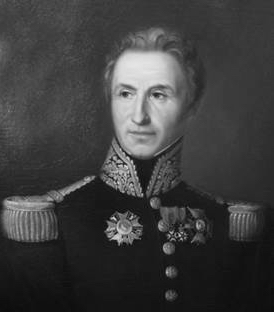General François Louis Bouchu

Born: November 13, 1771
Place of Birth: Is-sur-Tille, Côte-d'Or, France
Died: October 31, 1839
Place of Death: Antony, France
Arc de Triomphe: BOUCHU on the west pillar
Pronunciation:
The son of a merchant, François Louis Bouchu began his military career by joining the 2nd Battalion of Volunteers of Côte d'Or in September of 1791. He served with the Army of the North and in June of 1792 he was wounded and taken prisoner at the combat of Grisoüelle near Maubeuge. By the end of the year Bouchu was serving in the army again, and in January of 1793 he was commissioned as a lieutenant in the canonniers of his unit. Next he served with the Army of the Rhine and he fought at the combat of Rheinzabern and then in May he transferred to the Army of the Alps. Bouchu went on to serve at the Siege of Toulon and then in 1794 he joined the Army of Italy. He was promoted to capitaine in June of 1794.
In 1796 Napoleon Bonaparte took command of the Army of Italy and led it successfully into Italy. During this campaign Bouchu distinguished himself at Ceva, the blockade of Mantua, and the Battle of Castiglione . In March of 1797 he distinguished himself at the crossing of the Tagliamento. Bouchu next joined the Army of the Orient in 1798 and he took part in the actions at Malta and Alexandria. Taking part in the expedition to Syria, he participated in the Siege of Jaffa, the Siege of Acre, and then served at Cairo. In April of 1800 Bouchu was promoted to chef de bataillon and he returned to France at the end of 1801 after the French surrender in Egypt.
During the years that followed, Bouchu organized a battalion of pontooneers in Strasbourg and then in 1803 he was named deputy director of bridges near the artillery park of the camps of the army forming along the French coast. When in 1805 the Grande Armée marched east to confront the Third Coalition, Bouchu was promoted to colonel and attached to the general staff of the artillery. However, in October he took command of the 3rd Foot Artillery. At the same time, Bouchu was named director of the soldiers who worked on bridges. In April of 1807 he was named director of the artillery park of the army.
In December of 1808 Bouchu was sent to Spain as chief of staff of the artillery of the Army of Spain. In November of 1809 he commanded the artillery of V Corps at the Battle of Ocaña . May of 1811 was a busy month for Bouchu as he was named a Knight of the Empire, he served at the actions around Badajoz, he fought at the Battle of Albuera , and then a few days later he was promoted to général de brigade in command of the artillery of V Corps in Andalusia. In February of 1812 he took command of the artillery of the right wing of the Army of the South in Spain. The following year he was named commander-in-chief of the artillery of the Army of the South until he was called to serve in the Saxon campaign. Once in Saxony, in July he became director of the soldiers who worked on bridges of the Grande Armée. That October Bouchu distinguished himself at the attack of the bridge of Meissen and he was named a Baron of the Empire. Next he took command of the artillery at Torgau. The Coalition forces laid siege to Torgau and the French surrendered in January of 1814 and Bouchu was taken prisoner at the surrender.
After the end of the war in 1814, Bouchu returned to France where he took command of the artillery school at Grenoble and was named a Knight of Saint Louis. In 1815 when Napoleon resumed power for the Hundred Days, Bouchu was named commander of the artillery of the Corps of the Eastern Pyrenees. He continued a successful military career after the Second Restoration and in 1816 he became director of the École Polytechnique.
Bibliography
- Divry, Arnauld. Les Noms Gravés sur l'Arc de Triomphe. Paris: L'Harmattan, 2017.
- Six, Georges. Dictionnaire Biographique des Généraux & Amiraux Français de la Révolution et de l'Empire (1792-1814). 2 vols. Paris: Gaston Saffroy, 2003.
Updated May 2019
© Nathan D. Jensen